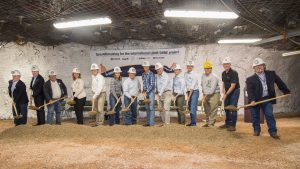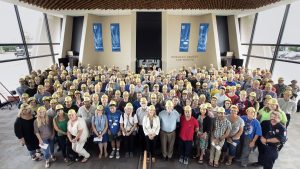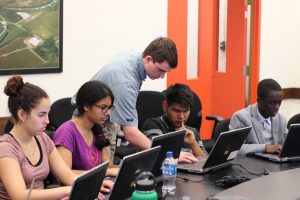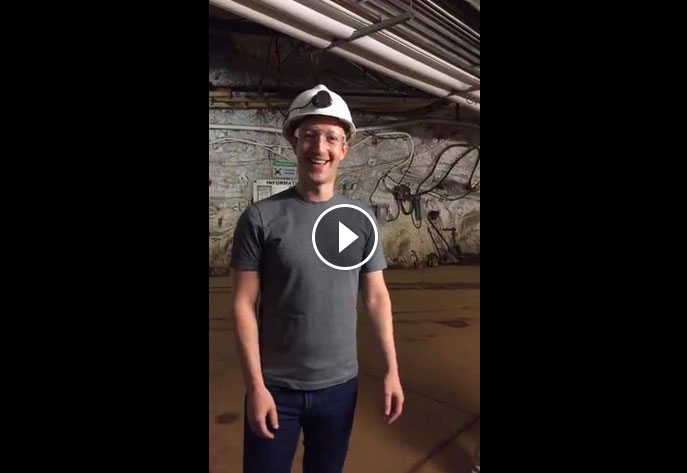Groundbreaking held today in South Dakota marks the start of excavation for the Long-Baseline Neutrino Facility, future home to the international Deep Underground Neutrino Experiment.

Ground is broken! Attending the underground ceremony today were, from left: Fermilab Director Nigel Lockyer; Executive Director of Programmes Grahame Blair, Science and Technology Facilities Council; Professor Sergio Bertolucci, National Institute for Nuclear Physics in Italy; Director for International Relations Charlotte Warakaulle, CERN; Rep. Randy Hultgren, Illinois; Rep. Kristi Noem, South Dakota; Sen. Mike Rounds, South Dakota; Sen. John Thune, South Dakota; Associate Director of Science for High-Energy Research Jim Siegrist, U.S. Department of Energy; Deputy Assistant to the President and Deputy U.S. Chief Technology Officer Michael Kratsios; South Dakota Governor Dennis Daugaard; Project Manager Scott Lundgren, Kiewit/Alberici; Executive Director Mike Headley, Sanford Underground Research Facility; and Chair of the Board Casey Peterson, South Dakota Science and Technology Authority. Photo: Reidar Hahn, Fermilab.
With the turning of a shovelful of earth a mile underground, a new era in international particle physics research officially began today.
In a unique groundbreaking ceremony held this afternoon at the Sanford Underground Research Facility in Lead, South Dakota, a group of dignitaries, scientists and engineers from around the world marked the start of construction of a massive international experiment that could change our understanding of the universe. The Long-Baseline Neutrino Facility (LBNF) will house the international Deep Underground Neutrino Experiment (DUNE), which will be built and operated by a group of roughly 1,000 scientists and engineers from 30 countries.
When complete, LBNF/DUNE will be the largest experiment ever built in the United States to study the properties of mysterious particles called neutrinos. Unlocking the mysteries of these particles could help explain more about how the universe works and why matter exists at all.
At its peak, construction of LBNF is expected to create almost 2,000 jobs throughout South Dakota and a similar number of jobs in Illinois. Institutions in dozens of countries will contribute to the construction of DUNE components. The DUNE experiment will attract students and young scientists from around the world, helping to foster the next generation of leaders in the field and to maintain the highly skilled scientific workforce in the United States and worldwide.
The U.S. Department of Energy’s Fermi National Accelerator Laboratory, located outside Chicago, will generate a beam of neutrinos and send them 1,300 kilometers (800 miles) through Earth to Sanford Lab, where a four-story-high, 70,000-ton detector will be built beneath the surface to catch those neutrinos.

Fermilab employees and scientific users celebrated the South Dakota groundbreaking ceremony remotely from Batavia, Illinois, watching the live video feed from Sanford Lab in Fermilab’s Ramsey Auditorium. Photo: Marty Murphy, Fermilab
Scientists will study the interactions of neutrinos in the detector, looking to better understand the changes these particles undergo as they travel across the country in less than the blink of an eye. Ever since their discovery 61 years ago, neutrinos have proven to be one of the most surprising subatomic particles, and the fact that they oscillate between three different states is one of their biggest surprises. That discovery began with a solar neutrino experiment led by physicist Ray Davis in the 1960s, performed in the same underground mine that now will house LBNF/DUNE. Davis shared the Nobel Prize in physics in 2002 for his experiment.
DUNE scientists will also look for the differences in behavior between neutrinos and their antimatter counterparts, antineutrinos, which could give us clues as to why the visible universe is dominated by matter. DUNE will also watch for neutrinos produced when a star explodes, which could reveal the formation of neutron stars and black holes, and will investigate whether protons live forever or eventually decay, bringing us closer to fulfilling Einstein’s dream of a grand unified theory.
But first, the facility must be built, and that will happen over the next 10 years. Now that the first shovel of earth has been moved, crews will begin to excavate about 800,000 tons of rock to create the huge underground caverns for the DUNE detector. Large DUNE prototype detectors are under construction at European research center CERN, a major partner in the project, and the technology refined for those smaller versions will be tested and scaled up when the massive DUNE detectors are built.

The DUNE neutrino beam will travel 1,300 kilometers (800 miles) through Earth from Fermilab in Illinois to Sanford Underground Research Facility in South Dakota. Illustration: Sandbox Studio/Fermilab
This research is funded by the U.S. Department of Energy Office of Science in conjunction with CERN and international partners from 30 countries. DUNE collaborators come from institutions in Armenia, Brazil, Bulgaria, Canada, Chile, China, Colombia, Czech Republic, Finland, France, Greece, India, Iran, Italy, Japan, Madagascar, Mexico, the Netherlands, Peru, Poland, Romania, Russia, South Korea, Spain, Sweden, Switzerland, Turkey, Ukraine, United Kingdom and the United States.
QUOTES
Energy Secretary Rick Perry
“The start of construction on this world-leading science experiment is cause for celebration, not just because of its positive impacts on the economy and on America’s strong relationships with our international partners, but also because of the fantastic discoveries that await us beyond the next horizon. I’m proud to support the efforts by Fermilab, Sanford Underground Research Facility and CERN, and we’re pleased to see it moving forward.”
Deputy Assistant to the President and Deputy U.S. Chief Technology Officer Michael Kratsios, Office of Science and Technology Policy
“Today’s groundbreaking for the Long-Baseline Neutrino Facility marks a historic moment for American leadership in science and technology. It also serves as a model for what the future of mega-science research looks like: an intensely collaborative effort between state, local and federal governments, international partners, and enterprising corporate and philanthropic pioneers whose combined efforts will significantly increase our understanding of the universe. The White House celebrates today with everyone who is bringing this once-in-a-generation endeavor to life, including the men and women providing the logistical organization and financial capital to set the project on the right foot, the physical labor to construct these incredible facilities, and the scientific vision to discover new truths through their work here.”
South Dakota Governor Dennis Daugaard
“This project will be one of the world’s most significant physics experiments conducted over the next several decades, and today’s groundbreaking is another milestone in the development of the Sanford Underground Research Facility.”
U.S. Senator John Thune, South Dakota
“The Long-Baseline Neutrino Facility continues Lead, South Dakota’s, tradition of cutting-edge neutrino research, dating back to physics experiments at the former Homestake Mine in the 1960s. When completed, LBNF and the Deep Underground Neutrino Experiment will attract some of the world’s brightest scientists to South Dakota and push the boundaries of basic research, not to mention support good-paying jobs in the historic mining region of the Black Hills. I look forward to seeing the facility’s completion and the groundbreaking experiments that will be done in the years to come.”
U.S. Senator Mike Rounds, South Dakota
“Today’s groundbreaking marks another significant step toward gaining a deeper understanding of the makeup of our universe. It is pretty remarkable that such world-class research continues to develop right here in Lead, South Dakota. When we began the process of securing an underground laboratory at South Dakota’s Homestake gold mine more than a decade ago, we were hopeful that it would lead to major advancements in particle physics and neutrino research. Today, those hopes are turning into reality as the Sanford Underground Research Facility, Fermilab and CERN join together to break ground on the Long-Baseline Neutrino Facility, which will house the Deep Underground Neutrino Experiment. Today is a truly special day, and I thank everyone involved in this collaboration for the years of hard work they’ve put into this project.”
U.S. Representative Kristi Noem, South Dakota
“In breaking ground today, we move closer to uncovering a new understanding of how the natural world works. That new knowledge could have a profound impact, potentially leading to faster global communications, better nuclear weapons detection technologies and a whole new field of research. The future of science is happening right here in South Dakota.”
U.S. Representative Randy Hultgren, Illinois
“The LBNF/DUNE groundbreaking once again puts the United States in a leadership position on the world stage, attracting scientists from around the globe to the only place they can do their work. Fermilab attracts top talent, employing nearly 2,000 in Illinois and providing a strong economic engine to our state. I commend the work done by the Department of Energy, Fermilab and Sanford Lab to bring together a strong coalition to serve the research needs of the international community. With great anticipation I look forward to the new and breathtaking discoveries made at this facility. What we all can learn together will be awe-inspiring and uncover the new questions that will drive future generations of scientists in their quest for greater understanding.”
Director Nigel Lockyer, Fermi National Accelerator Laboratory
“Fermilab is proud to host the Long-Baseline Neutrino Facility and the Deep Underground Neutrino Experiment, which bring together scientists from 30 countries in a quest to understand the neutrino. This is a true landmark day and the start of a new era in global neutrino physics.”
Executive Director Mike Headley, Sanford Underground Research Facility
“The South Dakota Science and Technology Authority is proud to be hosting LBNF at the Sanford Underground Research Facility. This milestone represents the start of construction of the largest mega-science project in the United States. We’re excited to be working with the project and the international DUNE collaboration and expanding our knowledge of the role neutrinos play in the makeup of the universe.”
Director-General Fabiola Gianotti, CERN
“Some of the open questions in fundamental physics today are related to extremely fascinating and elusive particles called neutrinos. The Long-Baseline Neutrino Facility in the United States, whose start of construction is officially inaugurated with today’s groundbreaking ceremony, brings together the international particle physics community to explore some of the most interesting properties of neutrinos.”
Executive Director of Programmes Grahame Blair, Science and Technology Facilities Council, United Kingdom
“The groundbreaking ceremony today is a significant milestone in what is an extremely exciting prospect for the UK research community. The DUNE project will delve deeper into solving the unanswered questions of our universe, opening the doors to a whole new set of tools to probe its constituents at a very fundamental level and, indeed, even addressing how it came to be. International partnerships are key to building these leading-edge experiments, which explore the origins of the universe, and I am very happy to be a representative of the international community here today.”
President Fernando Ferroni, National Institute for Nuclear Physics, Italy
“We are very proud of this great endeavor of Fermilab as its technology has roots in the work undertaken by Carlo Rubbia at the INFN Gran Sasso Laboratory in Italy.”
Professor Ed Blucher, University of Chicago and co-spokesperson, DUNE collaboration
“Today is extremely exciting for all of us in the DUNE collaboration. It marks the start of an incredibly challenging and ambitious experiment, which could have a profound impact on our understanding of the universe.”
Professor Mark Thomson, University of Cambridge and co-spokesperson, DUNE collaboration
“The international DUNE collaboration came together to realize a dream of a game-changing program of neutrino science; today represents a major milestone in turning this dream into reality.”
Editor’s note: The amount of rock to be excavated for LBNF at the South Dakota site mentioned in this article was updated on May 2, 2019.
Illustrations and animations of the LBNF/DUNE project and its science goals are available at:
http://www.dunescience.org/for-the-media
More information about the facility and experiment can be found at:
Fermilab is America’s premier national laboratory for particle physics and accelerator research. A U.S. Department of Energy Office of Science laboratory, Fermilab is located near Chicago, Illinois, and operated under contract by the Fermi Research Alliance, LLC. Visit Fermilab’s website at www.fnal.gov and follow us on Twitter at @Fermilab.
The DOE Office of Science is the single largest supporter of basic research in the physical sciences in the United States and is working to address some of the most pressing challenges of our time. For more information, please visit science.energy.gov.
Sanford Lab is operated by the South Dakota Science and Technology Authority (SDSTA) with funding from the Department of Energy. Our mission is to advance compelling underground, multidisciplinary research in a safe work environment and to inspire and educate through science, technology, and engineering. Visit Sanford Lab at www.SanfordLab.org.
On Friday, July 21, a new era of physics in the United States will officially begin.
The groundbreaking ceremony for the Long-Baseline Neutrino Facility (LBNF) that will support the Deep Underground Neutrino Experiment (DUNE) will be held one mile underground at the Sanford Underground Research Facility in South Dakota at 3:20 p.m. CDT/2:20 p.m. MDT and will be streamed live. A groundbreaking celebration will simultaneously be held at Fermilab in Illinois. Tune in to hear from these distinguished guests and watch them break ground for the world’s flagship project to study neutrinos:
Executive Director Mike Headley, Sanford Underground Research Facility
South Dakota Governor Dennis Daugaard
Deputy Assistant to the President and Deputy U.S. Chief Technology Officer Michael Kratsios, Executive Office of the President
Associate Director of Science for High Energy Physics Jim Siegrist, Department of Energy
U.S. Senator John Thune, South Dakota
U.S. Senator Mike Rounds, South Dakota
U.S. Representative Kristi Noem, South Dakota
U.S. Representative Randy Hultgren, Illinois
Director for International Relations Charlotte Warakaulle, CERN, Switzerland
Professor Sergio Bertolucci, University of Bologna and National Institute for Nuclear Physics, Italy
Executive Director of Programmes Grahame Blair, Science and Technology Facilities Council, United Kingdom
Director Nigel Lockyer, Fermi National Accelerator Laboratory
http://www.symmetrymagazine.org/article/shaking-the-dark-matter-paradigm

Thomas Hein is a returning student in the Fermilab TARGET program. This summer he’s helping current TARGET interns learn Python programming. Photo: Mario Lucero
How did you get involved with the TARGET program?
A little over a year ago, I attended a few of the Saturday Morning Physics lectures and heard about the TARGET program. I decided to apply and was accepted into the program.
What is your role in the Python programming course?
As a TARGET student last year, I worked with Ruth Pordes, my supervisor, along with Nate Knauf, another intern outside of the TARGET program, to create a Python course for other TARGET students. Nate Knauf and I created the teaching materials, and Ruth supervised the class. By the end of the program, every student had a solid understanding of the Python language.
This year, I was able to come back as an extended intern. I am now working with my new supervisor Marco Mambelli, the technical lead on the GlideinWMS project. The Python course is being given again this year, and Marco and I are leading it. It has been a lot of fun, and I look forward to each class.
Are you working on any other projects?
I am currently focused on the GlideinWMS project, updating the code base from an older version of Python to be compatible with Python version 3.6.
What are you planning on doing when you leave Fermilab?
I will be attending the University of Illinois at Chicago this fall, majoring in computer science. I hope to study machine learning and take some classes in electrical engineering as well.
What’s your favorite part of working here?
It’s a great atmosphere to work in, and the people here are amazing. This has been an incredible experience for me, and I’m glad to come into work every day.
On Wednesday, Facebook founder Mark Zuckerberg took to Facebook Live from a mile underground at the Sanford Underground Research Facility in South Dakota, future home of the Deep Underground Neutrino Experiment.
As of the date of this post, more than 2 million people have viewed Zuckerberg’s Facebook Live video, which discusses DUNE, neutrinos and the search for dark matter. Fermilab even gets a shout-out about 4 minutes in (3:55).
Watch Zuckerberg’s video for a glimpse of the DUNE host facility and to learn a little more about our research partners at Sanford Lab.


